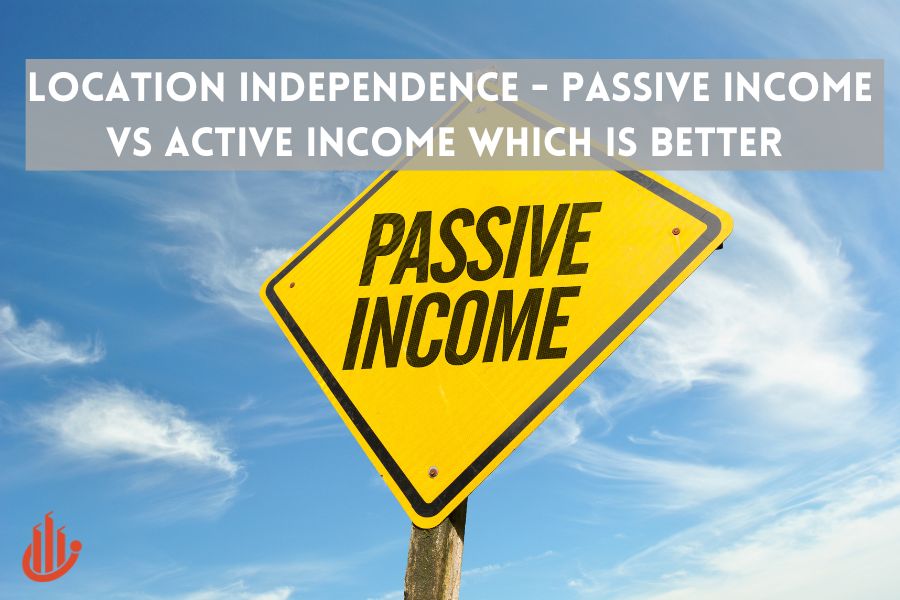If you are aiming to achieve full-time location independence, you may wonder whether you should focus on achieving completely automated, 100% passive income or if you are better off pursuing work that still requires trading time for money but without being tied to an office.
Throughout my fifteen years of earning a full-time living from the web, I have explored this question from various angles and experimented with different methods of making money while being location-independent. The answer, as you will discover, is that both approaches have their merits.
The order in which you pursue them and the strategies you employ depend on several factors. These include how much you can actually earn from each method in general, as well as how much you are likely to earn from any particular project, whether it involves passive or active income.
In this post, I will examine the advantages and disadvantages of each method of generating online income and debunk some common misconceptions about passive income being the only viable option.
Passive Income Is NOT Always Better
Passive income is often misunderstood as being superior to active income when it comes to achieving location independence. This misconception seems to stem from the influential personal finance book, Rich Dad, Poor Dad. While it is generally good advice to strive for a portfolio of income-generating assets alongside active income, the problem arises when individuals dismiss the idea of trading time for money before acquiring the necessary skills and investing the required time to develop passive income assets.
A prime example is Robert Kiyosaki, who spent two years selling Xerox machines door to door and honing his sales skills before starting his own business. For those new to online marketing, attempts at building passive income are likely to be met with limited success and low returns. The process involves intricate nuances that require time and experience to master.
In essence, the likelihood of achieving immediate success in generating passive income is fairly low without prior business and marketing experience. This is particularly true if one does not have access to adequate and reliable training resources, as there is an abundance of ineffective materials available.
Assessing Risk and Reward
Earning an active income through freelancing or services is generally considered a safer option. This is because you can secure payment before starting the work, minimizing the risks involved. In addition, when working on a client-by-client basis, you don’t have to invest a significant amount of time and money into product development before selling. Each client tends to bring in more revenue, allowing you to reach a comfortable full-time income with fewer customers.
On the other hand, building passive assets is more similar to launching a startup with a new product. There is often a considerable time and potentially financial investment before earning the first dollar. Furthermore, there is a possibility that the project may not generate any income at all, as some ventures fail.
The more time and money you invest before starting to earn from your venture, the higher the level of risk. To mitigate this risk, it is important to focus on projects that allow you to achieve your income goals and recoup your investment within a relatively short timeframe. In my experience, this is easier to accomplish with active income compared to passive income.
Passive income assets usually require a longer-term investment. Therefore, if you are investing your own time into building them, you need to carefully evaluate whether sacrificing immediate money for potential future earnings is worthwhile. It is crucial to determine how much more money you would need to earn in the future to justify the time input and over what time period.
The Mathematics of Active Versus Passive Income
Imagine being able to earn $50/hour as a freelancer, working on projects from anywhere in the world. This isn’t just your billable rate, but the average amount you earn even after accounting for the time spent on marketing and finding clients.
Now, let’s consider the idea of creating a simple passive income content website. The traffic for this website would come from search engines, and it would generate revenue through advertising and affiliate products, all with minimal effort on your part.
If it takes you 100 hours to build the website to a point where it can run on autopilot, how much would you need to earn from it to make it worthwhile? For example, if you invested those 100 hours and made $100/month from the site, would you be satisfied?
While you would have a passive income stream, in the first year, those 100 hours of work would only translate to $1200 in revenue. This may not seem great compared to the $5000 you could earn as a freelancer with the same level of effort. Additionally, you could potentially save and invest some of that freelancing income to grow it over the next five years.
The equation changes when you consider the potential sale value of the website. A fully passive website earning $100/month could potentially be sold for $1200-2400. If you were able to sell it for $2400 at the end of five years, it would generate a total of $7400.
However, there is a certain level of risk involved in this gamble. There is no guarantee that you will be able to sell the website or that it will continue earning the same amount in five years. The longer time frame also increases the level of uncertainty.
The dilemma can be summarized as follows: If your potential hourly rate is high, it may not be sensible to invest your own time in building passive income assets unless they have the potential to generate a substantial return.
If you have the ability to earn a high hourly rate but have not focused on building passive income assets, it may be more beneficial for you to save money from your active income sources and delegate the task of building digital assets to others.
Alternatively, you can develop the necessary skills to build highly profitable passive income assets. In this scenario, it would make more sense for you to invest your time in such projects.
In some cases, you may have a limited number of hours available for client work and wish to work more. In these situations, it would be wise to utilize those extra hours to build passive income assets.
What About Travel?
Passive income is often seen as the ideal source of income for those seeking location independence, as it allows individuals to earn money without actively working while on the move. However, it’s important to note that this perspective is not entirely accurate.
When comparing the earnings from freelancing for 100 hours versus dedicating the same amount of time to building a passive income site, the immediate financial gain from freelancing is still more favorable. Having a lump sum of cash saved is advantageous in such situations.
Ideally, it is beneficial to have both sources of income: saving lump sums from high-paying active work and generating passive income on a monthly basis. The main distinction arises when an individual lacks the ability to earn income on an hourly basis while being location-independent and is tied to a traditional office job. In such cases, passive income becomes an attractive option. However, it is worth considering that one may already possess a skill that can be sold online from anywhere.
Digital Passive Income Assets
Now, imagine if you could build that site without investing 100 hours of your time, but instead using money. In this case, different rules come into play, and it becomes a straightforward return-on-investment scenario.
The key questions to consider are the cost of building the site, how long it will take to recover that cost, and how much it will generate in earnings and for how long.
Let’s assume the site generates $100 per month and costs $600 to build. Your initial investment will be recouped in 6 months, and it will continue to generate $100 per month for an additional four and a half years.
This is an advantageous deal. By investing $600, you can turn it into $6000 over the span of five years. However, it’s important to note that the amount the site will actually generate is unknown in advance.
It could generate $500 or $1000 per month instead of $100, or it may not generate any revenue if there was an error in the process.
Active and Passive Income Strategies Need to Complement
Achieving the ideal scenario involves simultaneously implementing both a hustle income and a passive income strategy. A perfect example of this is what I accomplished with my client’s SEO business. Although I owned the company and had employees delivering most of the services, it was not considered passive income.
The hourly rate of running this company was significantly higher compared to the potential yield from other passive income projects I had at the time. Therefore, it made more sense to focus on growing this company and saving as much as possible from it.
To initiate the creation of passive assets, I utilized funds from my hustle income savings. Additionally, I leveraged the SEO infrastructure of my private blog network, which was established using revenue from my client business, to rank these passive income websites.
For instance, even a year after reducing my SEO clients to allocate more time for a major travel adventure, I still have a completely passive website earning $200-300 per month on autopilot with no maintenance required. This website was ranked using my private blog network and cost approximately $600 for outsourced content writing. In other words, it recoups its initial cost every 2-3 months and has been doing so for over 18 months.
By following this approach, you can effectively transform hustle income into long-term passive income.





